
COVID and Flu Jabs To Be Coadministered to Kids This Summer
The CDC's Advisory Committee on Immunization Practices (ACIP) recently unanimously voted 14-0 to coadminister the COVID-19 and flu vaccine to adults and children. The proposed policy for the 2021-2022 influenza season was made to implement changes that coincide with the timing of children returning to school in fall 2021, and to align with the CDC’s guidelines allowing COVID-19 vaccines to be coadministered with other vaccines.
July 9, 2021 | Source: Mercola.com | by Dr. Joseph Mercola
The CDC’s Advisory Committee on Immunization Practices (ACIP) recently unanimously voted 14-0 to coadminister the COVID-19 and flu vaccine to adults and children.1 The proposed policy for the 2021-2022 influenza season was made to implement changes that coincide with the timing of children returning to school in fall 2021, and to align with the CDC’s guidelines allowing COVID-19 vaccines to be coadministered with other vaccines.
This also will be the first influenza season2 where nearly all available flu vaccines are quadrivalent,3 rather than trivalent. This means flu shots will contain four vaccine strain influenza viruses — two influenza A viruses and two influenza B viruses.
The ACIP vaccine policy recommendations also included explicit information about when influenza vaccines should be given to children and adults.4 For example, the recommendations direct vaccine providers to give non-pregnant adults flu shots after August because of concerns about waning vaccine-acquired artificial immunity.
Vaccine providers are directed to give children flu shots by the end of October, with the dog kidney (MDCK) cell-based Flucelvax quadrivalent vaccine now being recommended for children starting at age 2 and older.
The policy also calls for precautions in giving a vaccine to anyone with a moderate or severe acute illness, history of Guillain-Barré syndrome within six weeks of receiving an influenza vaccine, or a history of severe allergic reactions to any other dose of flu vaccine.5
Unanimous Vote: CDC Approved One Flu and COVID Vaccine
In addition to approving the coadministration of flu and COVID-19 vaccines, ACIP warns that providers should be aware their patients may exhibit increased reactogenicity. This is a term health authorities use to describe expected adverse reactions to pharmaceutical products, especially hyper-inflammatory immunological responses to vaccination.
The literature6 calls it a “physical manifestation of the inflammatory response to vaccination” and “symptoms may include pain, redness, swelling or induration for injected vaccines, and systemic symptoms, such as fever, myalgia, headache or rash.”
In other words, the CDC expects more people to experience side effects/adverse reactions when influenza and COVID-19 vaccines are administered concurrently. ACIP member Dr. Matthew Daly believes that this year “Most adolescents will be vaccinated [against] COVID-19 in the summer and have their flu vaccination in the fall.”7
But coadministration of the two vaccines next year could increase the number of children receiving COVID-19 vaccine together with influenza vaccine and, subsequently, potentially increase reactogenicity. In the same meeting, the committee also voted unanimously to recommend a shorter rabies vaccination series for children traveling to areas where the potential risk is high.
Lastly, ACIP recommended the dengue vaccine for children ages 9 to 16 who live in areas where the virus is endemic. According to the CDC,8 the dengue virus spreads through the bite of a mosquito, infecting up to 400 million people each year. Each year, nearly 100 million will get sick and 22,000 will die from dengue.
No Evidence to Suggest Concurrent Vaccination Policy Is Safe
Despite the unanimous vote by CDC health experts charged with protecting the health of U.S. citizens, there is no evidence to suggest that giving children or adults influenza and COVID-19 vaccines simultaneously on the same day is safe. Some ACIP members noted the lack of data proving that concurrent vaccination policy is safe.
However, Medpage9 reports that CDC staff countered by citing one preprint study10 — published just days before the ACIP meeting — that examined the safety issues and efficacy of coadministering flu vaccine with the Novavax COVID-19 vaccine.
With this study, CDC staff noted there were “no changes in antibody titers for influenza vaccine and no safety issues” when give in combination, although participants did have greater tenderness or pain at the injection site, and higher levels of fatigue and muscle pain.
It’s also crucial to note that the information on which they based this decision was gathered from a sub-study of just 217 participants who had fewer comorbid conditions and were younger than those in their vaccine’s main study.11
Also important to note is that the experimental Novavax COVID-19 vaccine is a subunit protein,12 which is different from the mRNA COVID-19 vaccines. This means that information from the Novavax study cannot be extrapolated to the experimental mRNA vaccines now being administered under an EUA.13
Unlike the messenger RNA vaccines, which use genetic material to trigger the body to make parts of the SARS-CoV-2 spike protein, the Novavax vaccine’s protein adjuvant contains the spike protein as a nanoparticle.14 The manufacturer proposes that it stimulates the immune system to recognize the virus and resist infection.
Additionally, none of the mRNA COVID-19 vaccines being distributed under an EUA has been tested for safety and efficacy when coadministered with influenza vaccine. In other words, the CDC made a recommendation that the two vaccines can be given simultaneously to children and adults without providing data conclusively demonstrating safety or efficacy.
